|
President Zachary Taylor History
President Zachary Taylor : The Military President
Foreword
Zachary Taylor (1784-1850) was the 12th
President of the United States, but he had never seen a ballot box during his lifetime. As a career
soldier who never voted, he served fewer than 500 days in the White House. Yet he significantly influenced political developments
during the first half of 1850, when there was a domestic crisis and a grave possibility of imminent civil war. Taylor, a 41
year U.S. Army veteran, was considered a military genius and credited by many for the U.S. victory during the Mexican-American
War (1846-1848). Although he would ride his battlefield successes into the White House, the land acquired by the United
States as a result of the Mexican defeat would serve only to fuel the nation toward sectional conflict
as Northern and Southern politicians debated the expansion of slavery under newly elected President Taylor. While the nation
suffered the loss of 13,283 lives in its efforts to acquire nearly 50% of the territory owned by Mexico, it was rather
paltry compared to the 620,000 killed during the Civil War that would be fought just 13 years later. Taylor was
President during many heated slavery debates such as the Compromise of 1850, which included the Fugitive Slave Law,
and he hoped that a series of compromises would assuage tensions between the North and South. Although long
a slaveholder, Taylor was as much a Westerner as a Southerner, but he considered himself a Unionist and an American. He was
nationalistic in his orientation, seeking, above all, to preserve the Union. He fathered
6 children, 1 son and 5 daughters. His namesake, Richard, would become a prominent Confederate general and fight feverishly
to destroy the Union that he had toiled to preserve. And Taylor's daughter, Sarah Knox, married none other than
Jefferson Davis, the future president of the Confederacy. Because the dominant conspiracy theory of murder had abounded
since 1850, Zachary Taylor is the only U.S. president to have been exhumed in an effort to determine his cause of death. Taylor
was a staunch patriot who devoted his entire life to serving the country he so loved, but on the day prior
to his death he stated that his efforts were too feeble and insignificant for a grand nation that required and deserved
much more than the Kentucky native had already given. Few presidents, however, can equal the resume and public service
of Zachary Taylor, who many still refer to as "Old Rough and Ready." This following is
a photographic history of Taylor, and his premeditated poses and chosen attire allow us an impression and perhaps some
insight into the 12th president of the United States.
It would be remiss to remain silent on Zachary Taylor's lineage and
genealogy, which is as interesting as the growing nation he served, for it included some prominent names in American
history, such as his second cousin, President James Madison, and another cousin, the military genius Robert E. Lee. Through
his mother's Strother lineage, Taylor was a descendant of his Royal Lord Baltimore, the Founder of Maryland, and
he was also cousin to none other than a prominent Cherokee chief, who served in duel capacity of chief and state senator.
Taylor's colorful ancestry represented the harsh realities of the nation's melting
pot and its conflicting ideals. As the nation was struggling to find its national identity, Manifest Destiny and
growing sectionalism would eventually test its very core. America, during the era's worst and best of times, and the rise
of Taylor, from the backwoods of Kentucky to the chief executive of the nation, serve as reminders of our national simplicity
and unwavering patriotism, yet the bitter hardships and difficult decisions we face as Americans. As Zachary Taylor had
wished for the growing nation more than 150 years ago, we continue following our dreams of life, liberty, and the pursuit
of happiness.
| President Zachary Taylor died while in office |
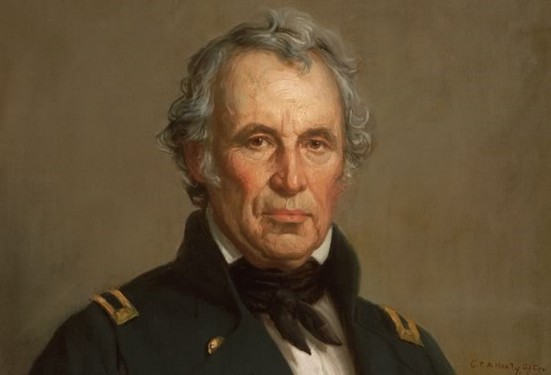
|
| President Zachary Taylor considered himself a Unionist and an American |
| General Zachary Taylor was the 12th President |
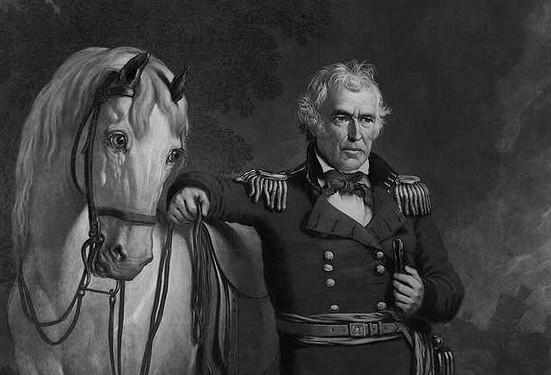
|
| Zachary Taylor rode his Mexican War fame straight into the White House |
| Rare photo of President Zachary Taylor, ca. 1849. |
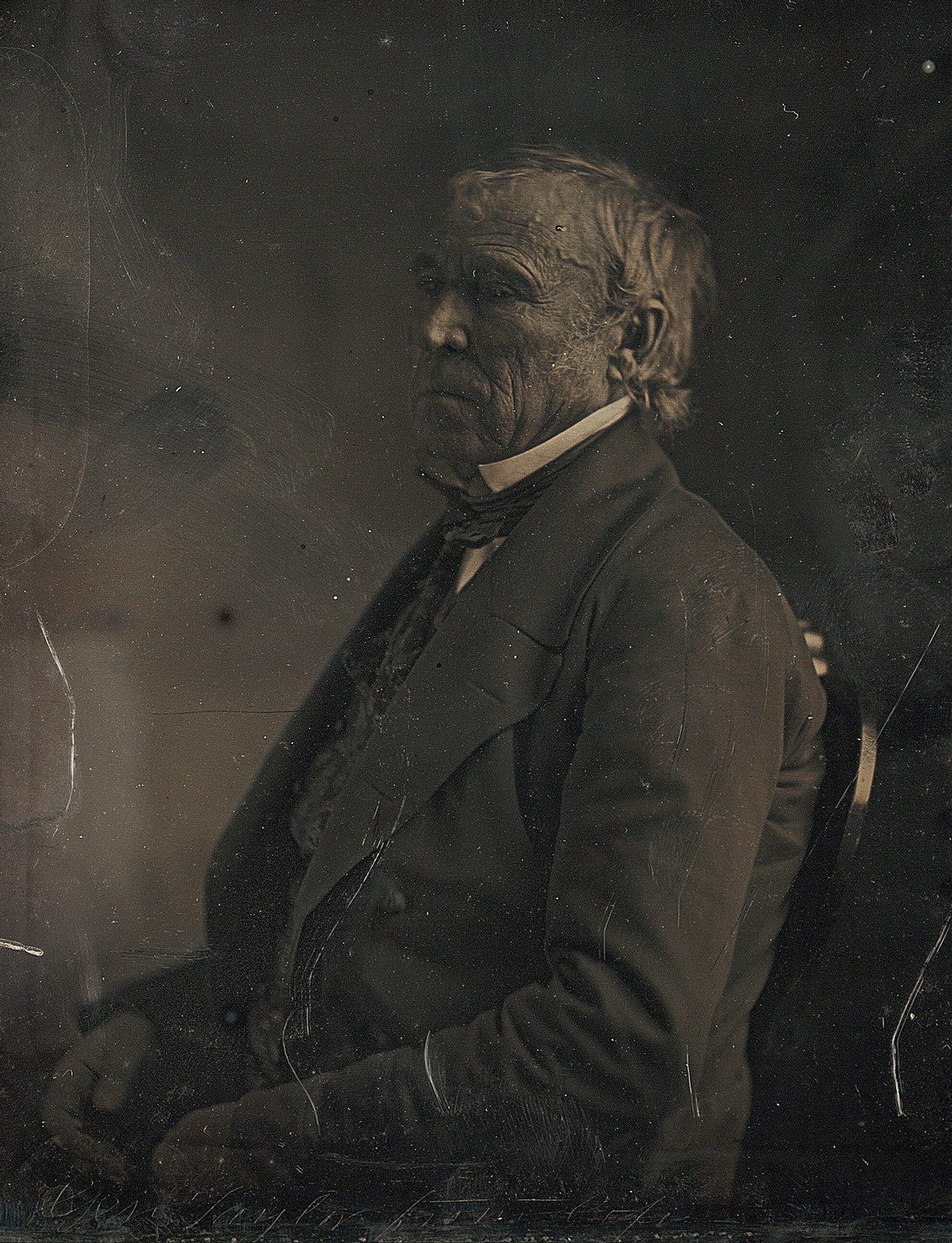
|
| Rare photo of President Zachary Taylor at the White House, ca. 1849. |
(About) High Resolution Daguerreotype portrait of President Zachary Taylor at the White House on March 1849,
by Mathew Brady. Library of Congress.
| 12th President Zachary Taylor |

|
| President Zachary Taylor Signature |
President Zachary Taylor: A History
| President Zachary Taylor |
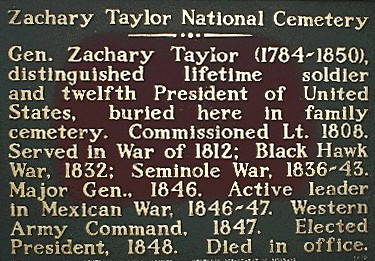
|
| President Zachary Taylor Historical Marker |
Summary
Zachary Taylor (November 24, 1784 – July 9, 1850) was the 12th President
of the United States, serving from March 1849 until his death in July 1850. Before his presidency, Taylor was a career officer
in the United States Army, rising to the rank of major general. His status as a national hero as a result of his victories
in the Mexican-American War won him election to the White House despite his vague political beliefs. His top priority as president
was preserving the Union, but he died sixteen months into his term, before making any progress on the status of slavery, which
had been inflaming tensions in Congress. Taylor was born to a prominent family of planters who migrated westward from Virginia
to Kentucky in his youth. He was commissioned as an officer in the U.S. Army in 1808 and made a name for himself as a captain
in the War of 1812. He climbed the ranks establishing military forts along the Mississippi River and entered the Black Hawk
War as a colonel in 1832. His success in the Second Seminole War attracted national attention and earned him the nickname
"Old Rough and Ready".
In 1845, as the annexation of Texas was underway, President James K. Polk
dispatched Taylor to the Rio Grande area in anticipation of a potential battle with Mexico over the disputed Texas–Mexico
border. The Mexican–American War broke out in May 1846, and Taylor led American troops to victory in a series of battles
culminating in the Battle of Palo Alto and the Battle of Monterrey. He became a national hero, and political clubs sprung
up to draw him into the upcoming 1848 presidential election.
The Whig Party convinced the reluctant Taylor to lead their ticket, despite
his unclear platform and lack of interest in politics. He won the election alongside U.S. Representative Millard Fillmore
of New York, defeating Democratic candidate Lewis Cass. As president, Taylor kept his distance from Congress and his cabinet,
even as partisan tensions threatened to divide the Union. Debate over the slave status of the large territories claimed in
the war led to threats of secession from Southerners. Despite being a Southerner and a slaveholder himself, Taylor did not
push for the expansion of slavery. To avoid the question, he urged settlers in New Mexico and California to bypass the territorial
stage and draft constitutions for statehood, setting the stage for the Compromise of 1850. Taylor died suddenly of a stomach-related
illness in July 1850, ensuring he would have little impact on the sectional divide that led to civil war a decade later.
| President Zachary Taylor |
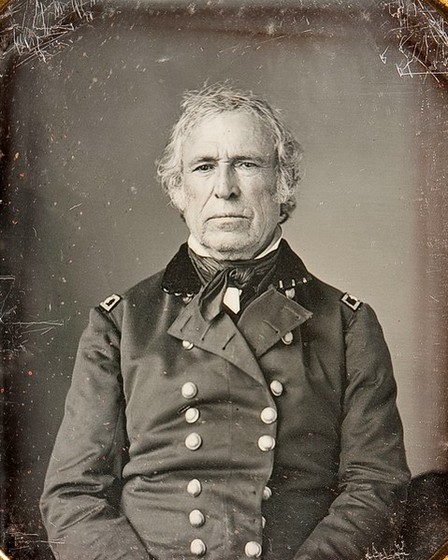
|
| President Zachary Taylor, ca. 1844. |
| President Zachary Taylor History |
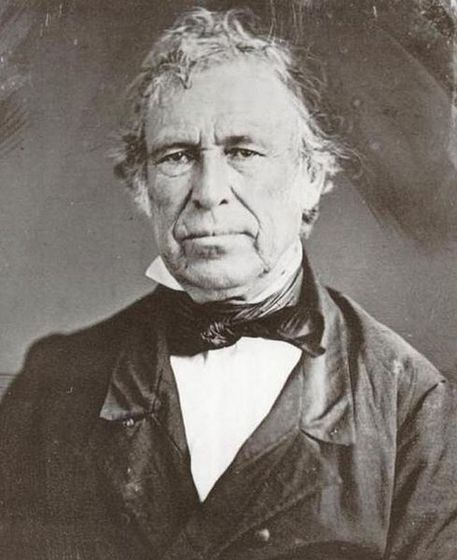
|
| President Zachary Taylor, ca. 1850. |
(Left) President Zachary Taylor in 1850, courtesy Library of Congress. (Right)
General Zachary Taylor. Daguerreotype of Taylor in uniform, ca. 1844. Half-Plate Daguerreotype of Zachary Taylor courtesy
Library of Congress.
| President Taylor was known as Old Rough and Ready |
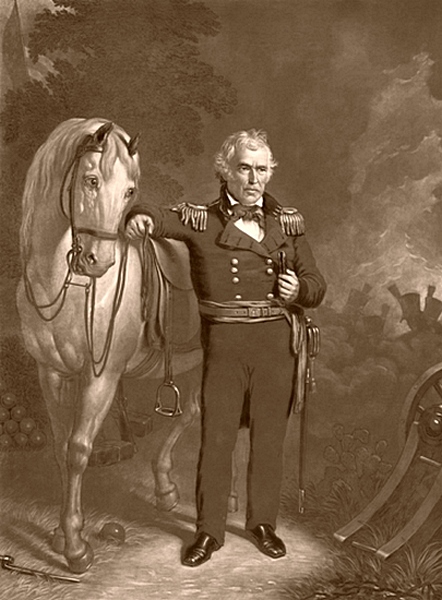
|
| General Zachary Taylor served 41 years in the army before his presidency. 1848, LOC. |
Eary Life
Zachary Taylor
(November 24, 1784 – July 9, 1850) was a member of several prominent families. One forebear was William Brewster, a
Mayflower pilgrim. James Madison was Taylor's second
cousin, and Robert E. Lee also was a kinsman. The 12th president's
father was Lt. Col. Richard Taylor of the Revolutionary Army. His mother was Sarah Dabney Strother Taylor, who was
a descendant of Lord Baltimore, the Founder of Maryland, and her Strother lineage included a prominent Cherokee chief, who, as cousin to "Old Rough and Ready," knew Zachary Taylor himself,
and influence that would prove invaluable to the Cherokee Indians. Zachary Taylor was born in Orange County, Va., on Nov. 24, 1784. A third child and
third son, he had six younger brothers and sisters. As an infant he was taken to what became Jefferson
County, Ky., and he grew to manhood on a farm near Louisville. His formal schooling was slight.
Taylor was born on November 24, 1784, on a plantation in Orange County,
Virginia, to a prominent family of planters of English ancestry. He is inconclusively believed to have been born at the home
of his maternal grandfather, Hare Forest Farm. He was the third of five surviving sons in his family (a sixth died in infancy)
and had three younger sisters. His mother was Sarah Dabney (Strother) Taylor. His father, Richard Taylor, had served as a
lieutenant colonel in the American Revolution. Taylor was a descendant of Elder William Brewster, the Pilgrim colonist leader
of the Plymouth Colony, a Mayflower immigrant, and one of the signers of the Mayflower Compact; and Isaac Allerton Jr., a
colonial merchant and colonel who was the son of Mayflower Pilgrim Isaac Allerton and Fear Brewster. Taylor's second cousin
through that line was James Madison, the fourth president.
Leaving exhausted lands, his family joined the westward migration out of
Virginia and settled near what developed as Louisville, Kentucky, on the Ohio River. Taylor grew up in a small woodland cabin
before his family moved to a brick house with increased prosperity. The rapid growth of Louisville was a boon for Taylor's
father, who came to own 10,000 acres throughout Kentucky by the start of the 19th century; he held 26 slaves to cultivate
the most developed portion of his holdings. There were no formal schools on the Kentucky frontier, and Taylor had a sporadic
formal education. A schoolmaster recalled Taylor as a quick learner. His early letters show a weak grasp of spelling and grammar,
and his handwriting was later described as "that of a near illiterate".
In June 1810, Taylor married Margaret Mackall Smith, whom he had met the
previous autumn in Louisville. "Peggy" Smith came from a prominent family of Maryland planters, and she was the daughter of
Major Walter Smith, who had served in the Revolutionary War. The couple had six children, 1 son and 5 daughters:
Ann Margaret Mackall Taylor (1811–1875), married Robert C. Wood,
a U.S. Army surgeon she had met while living Fort Snelling, in 1829.
Sarah Knox Taylor (1814–1835), married Jefferson
Davis in 1835, whom she had met through her father at the end of the Black Hawk War; she died at 21 of malaria in St. Francisville,
Louisiana, shortly after her marriage.
Octavia Pannill Taylor (1816–1820)
Margaret Smith Taylor (1819–1820),
died in infancy along with Octavia when the Taylor family was stricken with a "bilious fever"
Mary Elizabeth Taylor (1824–1909),
married William Wallace Smith Bliss (died 1853) in 1848
Richard "Dick" Taylor (1826–1879),[6] Confederate Army general
during the Civil War
| General Zachary Taylor in 1848 |
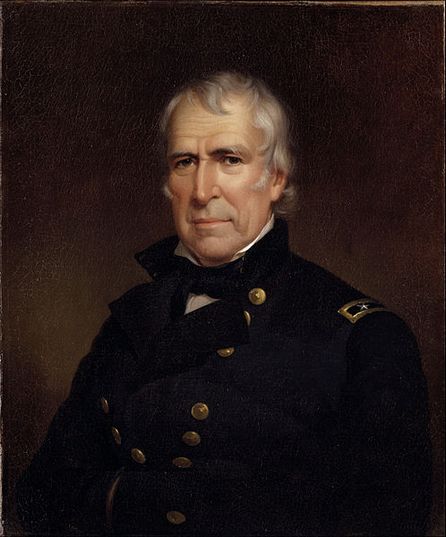
|
| Portrait of General Zachary Taylor in 1848 |
| President Zachary Taylor at Washington in 1849 |
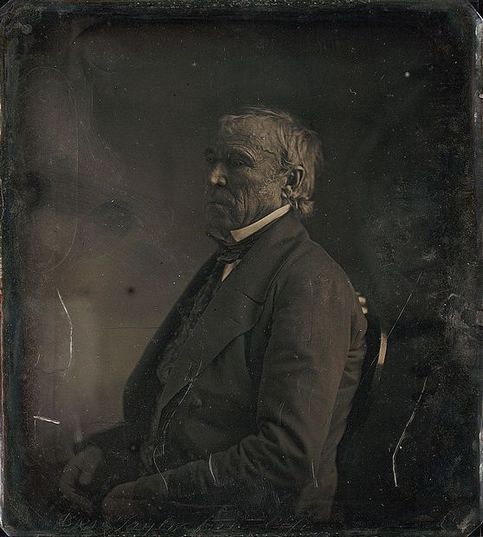
|
| President Zachary Taylor at the White House in 1849 |
| The Zachary Taylor House |
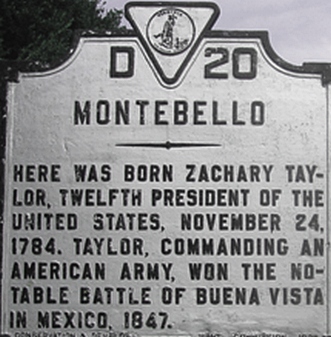
|
| Home of Zachary Taylor |
(Left) Daguerreotype portrait of President Zachary Taylor at the White House
by Mathew Brady in 1849. Daguerreotype of Zachary Taylor, taken at the White House, by photographer Mathew
Brady, in March 1849. Courtesy of the Beinecke Rare Book & Manuscript Library, Yale University. (Right) Portrait of General
Zachary Taylor by James Lambdin in 1848.
Early Military Career
In 1808, Taylor was commissioned a first lieutenant of infantry.
Two years later he married Margaret Mackall Smith of Calvert County, Md.
As a captain he won distinction in September 1812 for his defense of Fort Harrison in Indiana Territory against an Indian attack. For this achievement the young officer became the
first brevet major in the U.S. Army. In 1814, Taylor led U.S.
troops against British and Indians at Credit Island
in Illinois Territory.
Outnumbered three to one, he scored temporary successes before withdrawing. In 1815 he was promoted to the lineal grade of
major.
(Right) Born in 1784 at their Montebello Home, near Gordonsville, Orange County, Virginia, the Taylor family would relocate to Kentucky,
where Zachary Taylor would spend his early to young adult years at their "Springfield Home," located in Louisville. Taylor
lived there from 1790 to 1808, held his marriage there in 1810, and returned there periodically the rest of his life.
After a year as a civilian, Taylor reentered the army in 1816. At various times he served in the
states or future states of Wisconsin, Minnesota, Missouri, Mississippi, Louisiana,
Arkansas, and Oklahoma.
Commissioned a colonel in 1832, he fought in the Black Hawk War that year, participating in the Battle of Bad Axe.
Taylor acquired his nickname, "Old Rough and Ready," fighting the Seminole Indians in Florida Territory
from 1837 to 1840. His victory at the Battle of Okeechobee in 1837 was the single most successful U.S. effort of the protracted Second Seminole War. Breveted a brigadier general
in 1838, he commanded all U.S. troops in Florida. He emerged from the struggle with the reputation of a determined, resourceful leader.
There followed five placid years, 1840–1845, during which Taylor remained in the army, but also gave careful attention to his plantation in Mississippi. The annexation of Texas,
however, enabled him to receive his most important military assignment. In August 1845, he was in command of a small army
of regulars near the mouth of the Nueces River
at Corpus Christi, Texas.
Both the United States and Mexico
claimed the region between this river and the Rio Grande, and because Mexican military activity
was rumored, Taylor augmented his troops and awaited specific
instructions before moving through the disputed region.
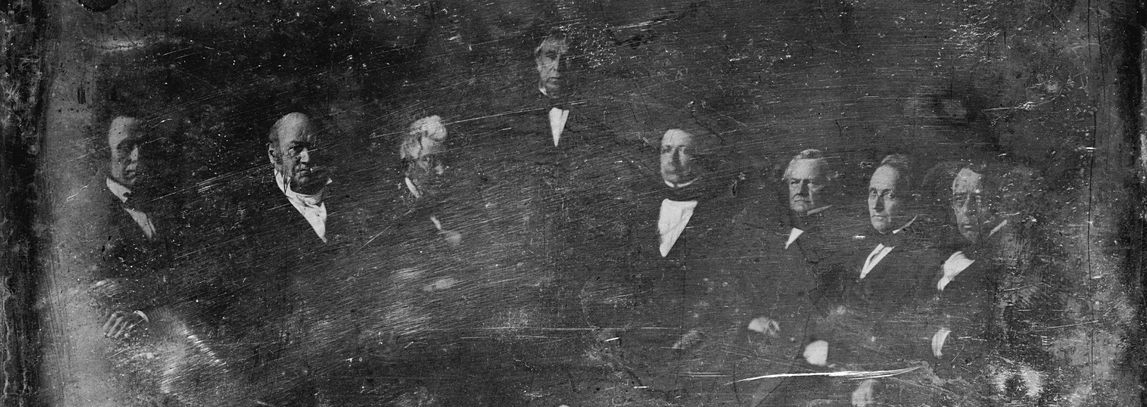
(About) President Zachary Taylor and his Cabinet, 1849. Daguerreotype by
Mathew Brady, December 31, 1848. From left to right: William B. Preston, Thomas
Ewing, John M. Clayton, Zachary Taylor, William M. Meredith, George W. Crawford, Jacob Collamer and Reverdy Johnson, (1849).
President Zachary Taylor's cabinet, daguerreotype by Mathew Brady, from the Library of Congress dated 1849.
Early Military Accomplishments and Achievements
On May 3, 1808, Taylor joined the U.S. Army, receiving a commission as a
first lieutenant of the Seventh Infantry Regiment. He was among the new officers commissioned by Congress in response to the
Chesapeake–Leopard Affair, in which an American frigate had been boarded by the crew of a British warship, sparking
calls for war. Taylor spent much of 1809 in the dilapidated camps of New Orleans and nearby Terre aux Boeufs. He was promoted
to captain in November 1810. His army duties were limited at this time, and he attended to his personal finances. Over the
next several years, he began to purchase slaves and a good deal of bank stock in Louisville. He bought a plantation in Louisville
for $95,000 that had 83 slaves attached to it, and another in Mississippi bringing the total number of slaves under him above
200. In July 1811 he was called to the Indiana Territory, where he assumed control of Fort Knox after the commandant fled.
In only a few weeks, he was able to restore order in the garrison, for which he was lauded by Governor William Henry Harrison.
During the War of 1812, in which U.S. forces battled the British Empire
and its Indian allies, Taylor successfully defended Fort Harrison in Indiana Territory from an Indian attack commanded by
the Shawnee chief Tecumseh. Taylor gained recognition and received a brevet (temporary) promotion to the rank of major. Later
that year he joined General Samuel Hopkins as an aide on two expeditions: the first into the Illinois Territory and the second
to the Tippecanoe battle site, where they were forced to retreat in the Battle of Wild Cat Creek. Taylor moved his growing
family to Fort Knox after the violence subsided. In spring 1814, he was called back into action under Brigadier General Benjamin
Howard. That October he supervised the construction of Fort Johnson, the last toehold of the U.S. Army in the upper Mississippi
River Valley. Upon Howard's death a few weeks later, Taylor was ordered to abandon the fort and retreat to Saint Louis. Reduced
to the rank of captain when the war ended in 1815, he resigned from the army. He re-entered it a year later after gaining
a commission as a major.
For two years, Taylor commanded Fort Howard at the Green Bay, Wisconsin
settlement. He then returned to Louisville and his family. In April 1819 he was promoted to the rank of lieutenant colonel
and dined with President James Monroe. In late 1821, Taylor took the 7th Infantry to Natchitoches, Louisiana, on the Red River.
On the orders of General Edmund P. Gaines, they set out to locate a new post more convenient to the Sabine River frontier.
By the following March, Taylor had established Fort Jesup, at the Shield's Spring site southwest of Natchitoches. That November
he was transferred to Fort Robertson at Baton Rouge, where he remained until February 1824. He spent the next few years on
recruiting duty. In late 1826 he was called to Washington, D.C., to work on an Army committee to consolidate and improve military
organization. In the meantime he acquired his first Louisiana plantation and decided to move with his family to Baton Rouge
as their home.
| Zachary Taylor Official White House Portrait |
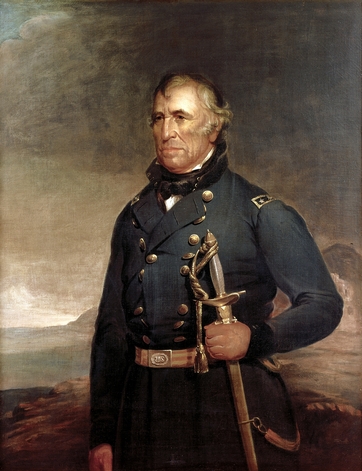
|
| President Zachary Taylor, ca. 1848. Official White House Portrait. |
| President Zachary Taylor |
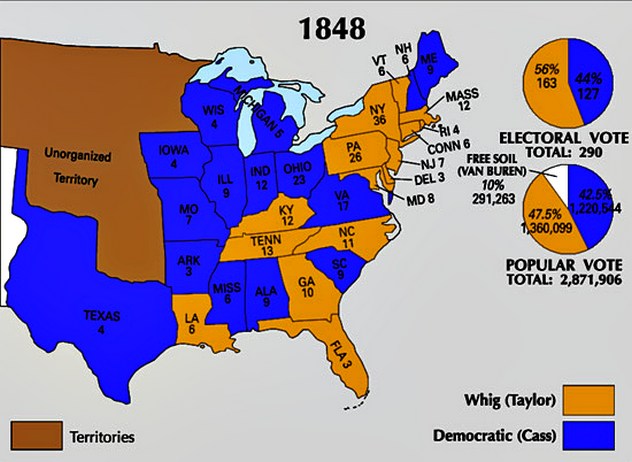
|
| Zachary Taylor wins 1848 Presidential Election. |
(Right) President Zachary Taylor, Created:
December 31, 1847. Joseph Henry Bush, The White House Historical Association.
| Zachary Taylor History Marker |
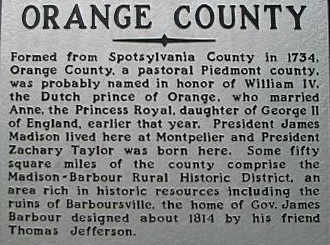
|
| Zachary Taylor Historical Marker |
In May 1828, Taylor was called back to action, commanding Fort Snelling
in Minnesota on the northern Mississippi River for a year, and nearby Fort Crawford for a year. After some time on furlough,
when he expanded his landholdings, Taylor was promoted to colonel of the 1st Infantry Regiment in April 1832. At that time,
the Black Hawk War was beginning in the West. Taylor campaigned under General Henry Atkinson to pursue and later defend against
Chief Black Hawk's forces throughout the summer. The end of the war in August 1832 signaled the end of Indian resistance to
U.S. expansion in the area, and the following years were relatively quiet. During this period Taylor resisted the courtship
of his 17-year-old daughter Sarah Knox Taylor and Lieutenant Jefferson Davis. He respected Davis but did not approve of his
daughter becoming a military wife, as he knew it was a hard life for families. Davis and Sarah Taylor married in June 1835,
but she died three months later of malaria contracted on a summer visit to Davis' sister in St. Francisville, Louisiana.
By 1837, the Second Seminole
War was underway when Taylor was directed to Florida. He defeated the Seminole Indians in the Christmas Day Battle of Lake
Okeechobee, which was among the largest U.S.–Indian battles of the nineteenth century. He was promoted to brigadier
general in recognition of his success. In May 1838, Brig. Gen. Thomas Jesup stepped down and placed Taylor in command
of all American troops in Florida, a position he held for two years. His reputation as a military leader was growing, and
with it, he began to be known as "Old Rough and Ready." 'Recommending the importation of Cuban bloodhounds to hunt down the
poor Indians' Taylor was widely condemned. After his long-requested relief was granted, Taylor spent a comfortable year touring
the nation with his family and meeting with military leaders. During this period, he began to be interested in politics and
corresponded with President William Henry Harrison. He was made commander of the Second Department of the Army's Western Division
in May 1841. The sizable territory ran from the Mississippi River westward, south of the 37th parallel north. Stationed in
Arkansas, Taylor enjoyed several uneventful years, spending as much time attending to his land speculation as to military
matter.
Republic of Texas to Mexican War
In anticipation of the annexation of the Republic of Texas, which had established
independence in 1836, Taylor was sent in April 1844 to Fort Jesup in Louisiana. He was ordered to guard against any attempts
by Mexico to reclaim the territory. He served there until July 1845, when annexation became imminent, and President James
K. Polk directed him to deploy into disputed territory in Texas, "on or near the Rio Grande" near Mexico. Taylor chose a spot
at Corpus Christi, and his Army of Occupation encamped there until the following spring in anticipation of a Mexican attack.
| President Zachary Taylor |

|
| President Zachary Taylor in 1850 US Census |
(About) With real estate holdings
valued at $100,000 in 1850, Zachary Taylor was a very wealthy man for the era. Although Taylor died on July 9, 1850, the US
Census was not enumerated until August 31, 1850, thus reconciling what appears to be a discrepancy.
Taylor's men advanced to the Rio Grande in March 1846. Polk's attempts to
negotiate with Mexico had failed, and war appeared imminent. Violence broke out several weeks later, when some of Captain
Seth B. Thornton's men were attacked by Mexican forces near the river. Polk, learning of the Thornton Affair, told Congress
in May that a war between Mexico and the U.S. had begun. That same month, Taylor commanded American forces at the Battle of
Palo Alto and the nearby Battle of Resaca de la Palma, defeating the Mexican forces, which greatly outnumbered his own. These
victories made him a popular hero, and within weeks he received a brevet promotion to major general and a formal commendation
from Congress. The national press compared him to George Washington and Andrew Jackson, both generals who had ascended to
the presidency, although Taylor denied any interest in running for office. "Such an idea never entered my head," he remarked
in a letter, "nor is it likely to enter the head of any sane person."
In September, Taylor inflicted heavy casualties upon the Mexican defenders
at the Battle of Monterrey. The city of Monterrey had been considered "impregnable", but was captured in three days, forcing
Mexican forces to retreat. Taylor was criticized for signing a "liberal" truce, rather than pressing for a large-scale surrender.
Afterwards, half of Taylor's army was ordered to join General Winfield Scott's soldiers as they besieged Veracruz. Mexican
General Antonio López de Santa Anna discovered, through an intercepted letter from Scott, that Taylor had contributed all but 6,000 of his men
to the effort. His remaining force included only a few hundred regular army soldiers, and Santa Anna resolved to take advantage
of the situation.
Santa Anna attacked Taylor with 20,000 men at the Battle of Buena Vista
in February 1847, leaving around 700 Americans dead or wounded at a cost of over 1,500 Mexican. Outmatched, the Mexican forces
retreated, ensuring a "far-reaching" victory for the Americans.
In recognition of his victory at Buena Vista, Taylor was elected an honorary
member of the New York Society of the Cincinnati on July 4, 1847. Taylor's father had been an Original Member of the Virginia
Society of the Cincinnati. Unfortunately for the younger Taylor, the Virginia society had disbanded shortly before the elder
Taylor's death, which prevented him from succeeding to his father's "seat" in the Society.
Taylor remained at Monterrey until late November 1847, when he set sail
for home. While he would spend the following year in command of the Army's entire western division, his active military career
was over. In December he received a hero's welcome in New Orleans and Baton Rouge, and his popular legacy set the stage for
the 1848 presidential election.
| Mexican American War (1846-1848) |
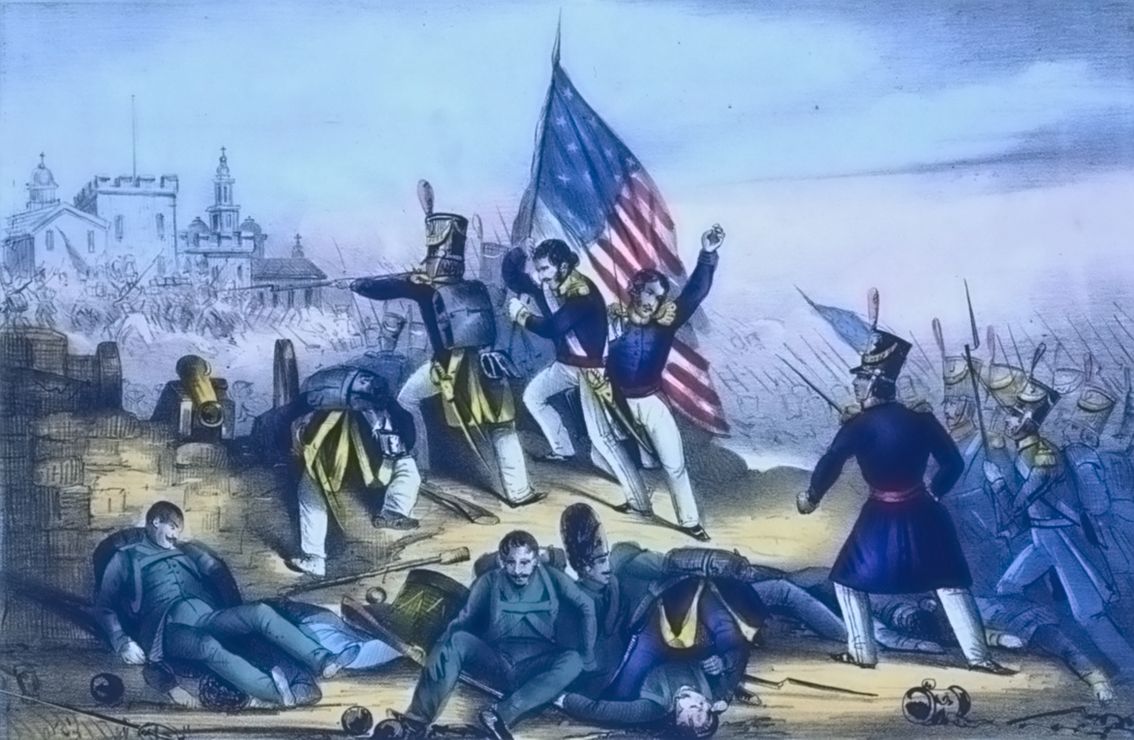
|
| An American victory at the Battle of Chapultepec. Digitally enhanced. |
(Above) Attack on Chapultepec, Sept. 13, 1847, where the Mexicans were
routed and lost many men. E.B. & E.C. Kellogg (Firm). Library of Congress Prints and Photographs Division. Ca.
1847-'48. Gen. Zachary Taylor, however, had his greatest victory at the Battle of Buena Vista, where his army of some
4,500 soldiers engaged Antonio Lopez de Santa Anna's command of more than 15,000 troops. Outnumbered by more than 3-to-1,
Taylor's army, although it suffered slightly more than 600 casualties, delivered a devastating defeat to Santa Anna, of Alamo
fame, whose staggering losses totaled more than 3,500 casualties.
Mexican War Service
Early in 1846 the order came. Advancing to his new supply base at Point
Isabel, General Taylor ordered the construction of Fort Texas (later Fort
Brown, site of Brownsville, Texas)
on the American side of the Rio Grande opposite Matamoros.
Nearby on April 25 about 1,600 Mexican soldiers, who had crossed the river, surrounded an American detachment and killed or
captured its members. This was the unofficial start of the Mexican War. Taylor set out for
Point Isabel to secure his base and, after several days devoted to strengthening its defenses, began a return march to relieve
Fort Texas,
which had come under Mexican bombardment.
The American force of 2,228 found its route blocked by a Mexican army
more than twice its size. On May 8 at Palo Alto, 12 miles northeast of Fort
Texas, Mexican Gen. Mariano Arista opened cannon fire, and Taylor retaliated. Palo Alto
was the war's first battle. It was a minor U.S.
victory, which demonstrated the superiority of American artillery.
The next day told a more dramatic story. Arista fell back 5 miles to
terrain where embankments, underbrush, and chaparral offset the effectiveness of Taylor's
cannon. The fight at Resaca de la Palma that afternoon was especially bloody. Little headway could be made against the strong
Mexican right flank by the greatly outnumbered Americans. But before the insistent hammering of Taylor's infantrymen, Arista's left flank was turned, and his army crumbled. The Mexicans
retreated hastily across the Rio Grande. Fort Texas was safe and the American army triumphant.
The Mexicans suffered three times as many casualties as the Americans.
The two May victories resulted in Taylor's
becoming not only a major general but also a national hero. Then, Congress having declared war, volunteer regiments made it
possible for "Old Rough and Ready" to have 6,641 troops when he launched his attack on Monterrey
on Sept. 21, 1846. Northern Mexico's largest community proved to be well defended. Gen. Pedro
de Ampudia's army of 7,303 held many advantages behind fortified hills and adjacent strong-points. Much of the fighting was
house-to-house as sharpshooters fired from doorways, windows, and roofs while artillery controlled the streets and plazas.
For three days the combat raged. Finally, Ampudia broached an eight-week armistice, stipulating his willingness to surrender
the city if Taylor would permit withdrawal of the Mexican
troops. Because his supply lines were extended and this seemed the best result he could obtain, Taylor accepted Ampudia's proposal.
Despite the indecisive outcome and the numerous U.S.
casualties, many Americans at home regarded Monterrey as a third Taylor success. Not so President James K. Polk. Losing confidence in Taylor, Polk transferred most of the seasoned soldiers to Gen. Winfield Scott. Polk himself, however, made a serious mistake. He gave the exiled Mexican dictator
Antonio López de Santa Anna a safe-conduct through the U.S. naval blockade in the belief that the opportunistic firebrand would arrange peace negotiations.
Instead, Santa Anna attacked Taylor.
The Battle of Buena Vista on Feb. 22–23, 1847, marked the climax
of Taylor's Mexican War service. With fewer than 500 regulars
in his force of 4,760, he was outnumbered by Santa Anna four to one. Amid crags and gullies near Saltillo, the doughty commander halted waves of mounted and dismounted assailants and turned
the tide in counterassaults. After two days of struggle, Santa Anna retreated from the rugged terrain. The field and the victory
were Taylor's.
| President Zachary Taylor Cemetery |
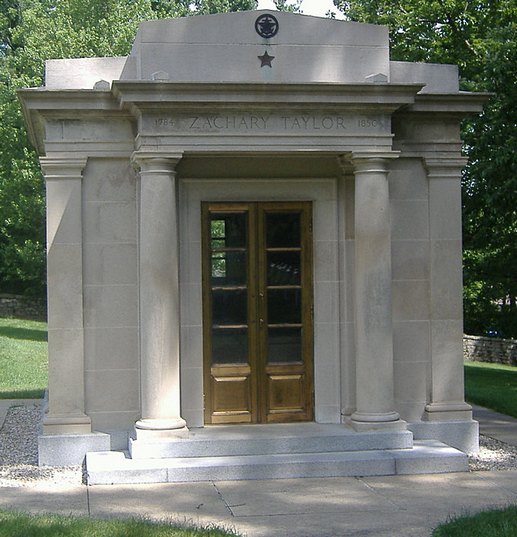
|
| President Zachary Taylor buried in mausoleum. |
| President Zachary Taylor and wife burial plots |
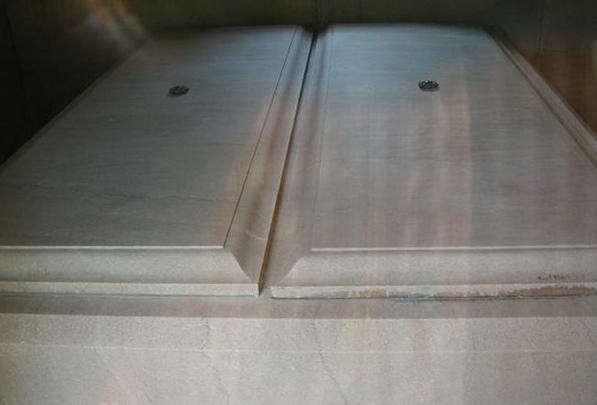
|
| President Zachary Taylor (L); Margaret Smith (R) |
(About) Zachary Taylor National Cemetery, Louisville, Kentucky. A mausoleum
houses the remains of Zachary Taylor and his wife at Zachary Taylor National Cemetery. Monuments and Memorials: A 50-foot
granite monument topped with the life-size figure of former president Zachary Taylor was erected by the state of Kentucky
in 1883.Zachary Taylor National Cemetery is closed to new interments. The only interments that are being accepted are subsequent
interments for veterans or eligible family members in an existing gravesite. Periodically however, burial space may become
available due to a canceled reservation or when a disinterment has been completed. When either of these two scenarios occurs,
the gravesite is made available to another eligible veteran on a first-come, first-served basis. Since there is no way to
know in advance when a gravesite may become available, please contact the cemetery at the time of need to inquire whether
space is available.
Politics
In his capacity as a career officer, Taylor had never reportedly revealed
his political beliefs before 1848 nor voted before that time. He thought of himself as an independent, believing in a strong
and sound banking system for the country, and thought that President Andrew Jackson should not have allowed the Second Bank
of the United States to collapse in 1836. He believed it was impractical to talk about expanding slavery into the western
areas of the U.S., as he concluded that neither cotton nor sugar (both were produced in great quantities as a result of slavery)
could be easily grown there through a plantation economy. He was also a firm nationalist, and due to his experience of seeing
many people die as a result of warfare, he believed that secession was not a good way to resolve national problems. Taylor,
although he did not agree with their stand in favor of protective tariffs and expensive internal improvements, aligned himself
with Whig Party governing policies: the President should not be able to veto a law, unless that law was against the Constitution;
that the office should not interfere with Congress; and that the power of collective decision-making, as well as the Cabinet,
should be strong.
Well before the American victory at Buena Vista, political clubs were
formed which supported Taylor for President. His support was drawn from an unusually broad assortment of political bands,
including Whigs and Democrats, Northerners and Southerners, allies and opponents of national leaders such as Henry Clay and
James K. Polk. By late 1846 Taylor's opposition to a presidential run began to weaken, and it became clear that his principles
more closely resembled Whig orthodoxy. Still, he maintained that he would only accept election as a national, independent
figure, rather than a partisan loyalist. Taylor declared, as the 1848 Whig Party convention approached, that he had always
been a Whig in principle, but he did consider himself a Jeffersonian-Democrat. Many southerners believed that Taylor supported
slavery and its expansion into the new territory absorbed from Mexico, and some were angered when Taylor suggested that if
he were elected President he would not veto the Wilmot Proviso, which proposed against such an expansion. This position did
not enhance his support from activist antislavery elements in the Northern U.S., as these wanted Taylor to speak out strongly
in support of the Proviso, not simply fail to veto it. Most abolitionists did not support Taylor, since he was a slave-owner.
Many southerners also knew that Taylor supported states' rights and was
opposed to protective tariffs and government spending for internal improvements. The Whigs hoped that he put the federal union
of the United States above all else. Taylor received the Whig nomination for President in 1848. For his Vice Presidential
nominee the convention chose Millard Fillmore, a prominent New York Whig who had chaired the House Ways and Means Committee
and had been a contender for Henry Clay's Vice Presidential nominee in the 1844 election. Fillmore's selection was largely
an attempt at reconciliation with northern Whigs, who were furious at the election of a slaveowning southerner; all factions
of the party were dissatisfied with the final ticket. Taylor continued to minimize his role in the campaign, preferring not
to directly meet with voters or correspond regarding his political views. His campaign was skillfully directed by Senator
John J. Crittenden of Kentucky, a friend and early political supporter, and bolstered by a late endorsement from Senator Daniel
Webster of Massachusetts. Taylor defeated Lewis Cass, the Democratic candidate, and Martin Van Buren, the Free Soil candidate.
Taylor ignored the Whig platform, as historian Michael F. Holt explains:
Taylor was equally indifferent to programs Whigs had long considered
vital. Publicly, he was artfully ambiguous, refusing to answer questions about his views on banking, the tariff, and internal
improvements. Privately, he was more forthright. The idea of a national bank "is dead, and will not be revived in my time."
In the future the tariff "will be increased only for revenue"; in other words, Whig hopes of restoring the protective tariff
of 1842 were vain. There would never again be surplus federal funds from public land sales to distribute to the states, and
internal improvements "will go on in spite of presidential vetoes." In a few words, that is, Taylor pronounced an epitaph
for the entire Whig economic program.
| Zachary Taylor Historical Marker |
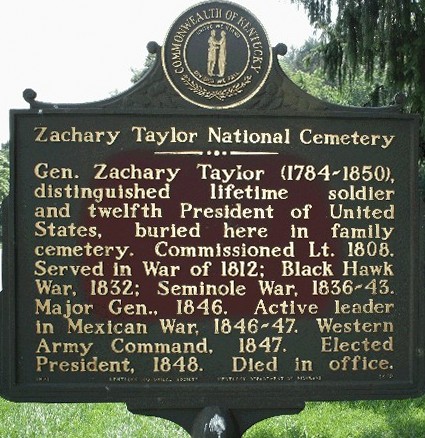
|
| Zachary Taylor National Cemetery |
| 12th U.S. President Zachary Taylor, 1849 |
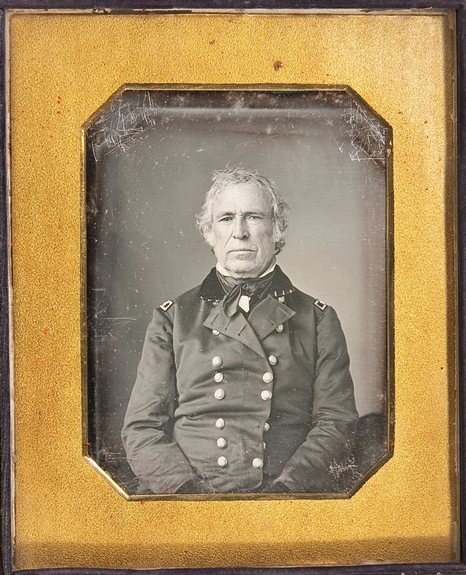
|
| Rare photo of President Zachary Taylor, 1849, Library of Congress |
| Zachary Taylor for President |
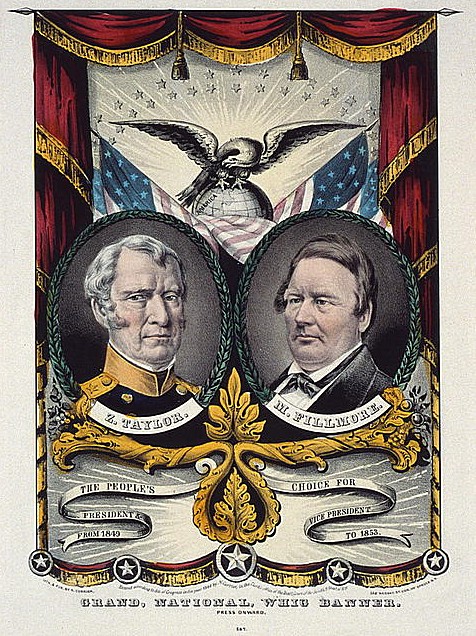
|
| Taylor / Fillmore Ticket |
Election of 1848
Buena Vista, more than anything else, elevated Taylor
to the presidency. His unassuming personality, earthiness, and courage contributed substantially to his appeal. The Whig party,
trying to repeat its one great success with William Henry Harrison in 1840, nominated this second old soldier as its presidential
candidate in June 1848. Taylor was a military hero whose views
on the crucial issues of the day were not well enough known to be damaging. His ownership of blacks and a cotton plantation
helped in the South.
(Right) Grand National Whig banner.
Library of Congress Prints and Photographs online collection. This image is available from the United States Library of Congress's
Prints and Photographs division under the digital ID cph.3b48485.
Taylor's
opponents in the campaign were Democrat Lewis Cass and Free Soil standard-bearer Martin Van Buren. The main issue was the
extension of slavery into the vast regions ceded by Mexico to the United States in the Treaty of Guadalupe Hidalgo, which ended
the Mexican War. While Van Buren explicitly opposed extension, neither major-party aspirant took a clear position. Van Buren,
a former Democrat, split the Democratic vote in pivotal New York.
Taylor defeated Cass 163 to 127 in the electoral college.
Taylor carried half the states, seven in the North and eight
in the South. His popular vote was 1,362,101; Cass', 1,222,674; Van Buren's, 291,616.
Transition and Inauguration
As president-elect, Taylor kept his distance from Washington, not resigning
his Western Division command until late January 1849. He spent the months following the election formulating his cabinet selections.
He was deliberate and quiet about his decisions, to the frustration of his fellow Whigs. While he despised patronage and political
games, he endured a flurry of advances from office-seekers looking to play a role in his administration.
While he would not appoint any Democrats, Taylor wanted his cabinet to reflect
the nation's diverse interests, and so apportioned the seats geographically. He also avoided choosing prominent Whigs, sidestepping
such obvious selections as Henry Clay. He saw Crittenden as a cornerstone of his administration, offering him the crucial
seat of Secretary of State, but Crittenden insisted on serving out the Governorship of Kentucky to which he had just been
elected. Taylor settled instead on Senator John M. Clayton of Delaware, a close associate of Crittenden's.
Taylor began his trek to Washington in late January, a journey rife with bad
weather, delays, injuries, and sickness. Taylor finally arrived in the nation's capital on February 24 and soon met with the
outgoing President Polk. The incumbent Democrat held a low opinion of Taylor, privately deeming him "without political information"
and "wholly unqualified for the station" of President. Taylor spent the following week meeting with political elites, some
of whom were unimpressed with his appearance and demeanor. With less than two weeks until his inauguration, he met with Clayton
and hastily finalized his cabinet.
Taylor's term as president began Sunday, March 4, but his inauguration was
not held until the following day out of religious concerns. His inauguration speech discussed the many tasks facing the nation,
but presented a governing style of deference to Congress and sectional compromise instead of assertive executive action. Throughout
the summer of 1849, Taylor toured the northeastern U.S., to familiarize himself with a region of which he had seen little.
He spent much of the trip plagued by gastrointestinal illness and returned to Washington by September.
12th President of the United States
Zachary Taylor was president from March 5, 1849, to July 9, 1850. The
Thirty-first Congress, which did not assemble until December 1849, had a Democratic plurality in the House and a Democratic
majority in the Senate. Its members were far from agreement on the burning issues of the times.
Many Southern senators and representatives favored projecting the Missouri Compromise line of 36° 30' to the Pacific Ocean, with
slavery legal south of the line. Other senators, notably Henry Clay and Stephen A. Douglas, supported mutual concessions,
including the application of popular sovereignty to two western territories they wished to create. Taylor
rejected those schemes, the "President's Plan" being limited to the admission of California
and New Mexico as states.
Because California had applied to enter
the Union as a free state, and it was thought that New Mexico
would follow suit, Taylor's stand was clearly anti-extension.
His congressional backing consisted almost wholly of free-state Whigs. With two exceptions, every Northern Whig senator explicitly
or implicitly sided with the president.
Thus Taylor's
role is vital to an understanding of the memorable debates of 1850, during which some congressmen carried firearms, and prominent
politicians were involved in fist-fights. There was fear and danger of civil war and a possibility that the Texas
militiamen would attempt to drive the U.S. Army out of Santa Fe
before the year was over. A Unionist in the Jacksonian tradition, President Taylor made it clear that he would not hesitate
to employ the full authority of his office to quell rebellion in any form.
Taylor died in Washington, D.C., on July 9, 1850, when the national crisis
was particularly acute. Except for the dramatic congressional speeches over the extension of slavery—some among the
most famous in American history—the sole major event associated with the Taylor administration is the signing of the
Clayton-Bulwer Treaty with Britain, which provided for control over a future canal or other route across Central America.
| President Zachary Taylor Memorial |
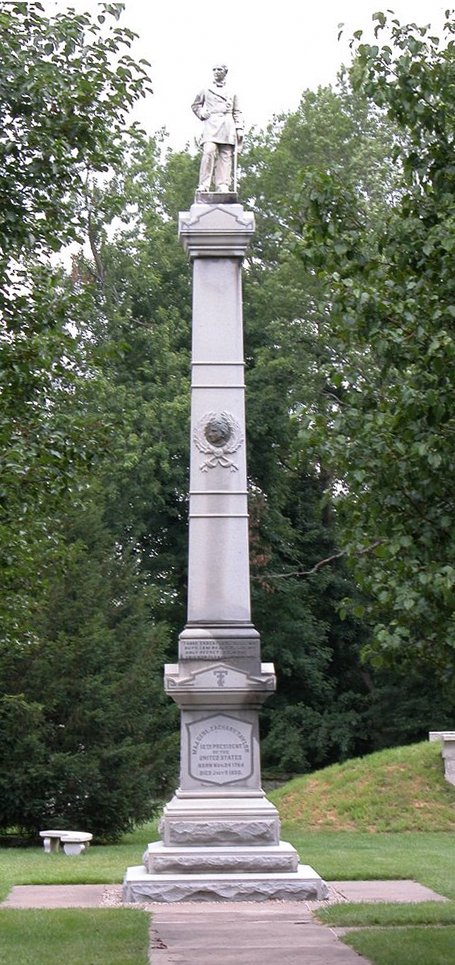
|
| President Zachary Taylor Monument |
| President Zachary Taylor Cemetery |
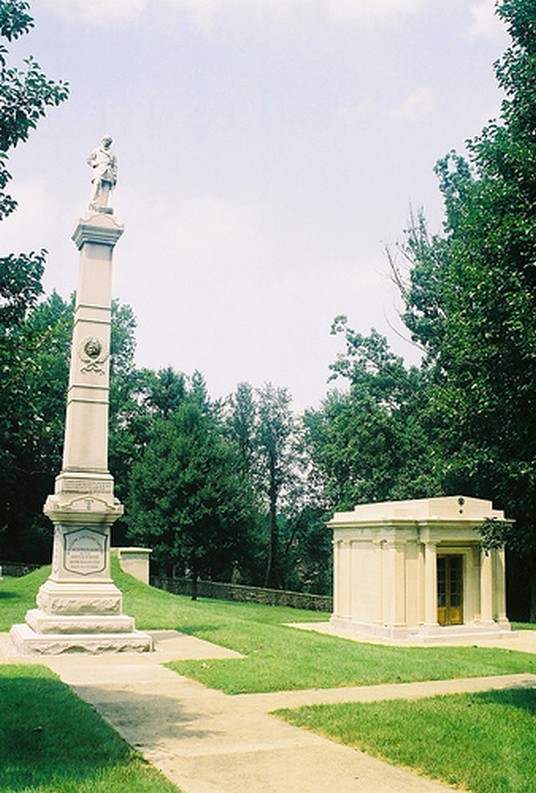
|
| Zachary Taylor Mausoleum and Memorial |
Domestic Crisis
As Taylor took office, Congress faced a battery of questions related to
the Mexican Cession, comprising three major territories acquired by the U.S. after the Mexican War: California, New Mexico,
and Utah. It was unclear which of the acquisitions would achieve statehood and which would remain federal territories, while
the question of their slave status threatened to bitterly divide Congress. While a southern slaveowner himself, Taylor had
no particular bias toward the southern faction of Congress which sought to maintain its right to slavery. His major goal was
sectional peace, preserving the Union through legislative compromise. As the threat of Southern secession grew, he sided increasingly
with northern abolitionists such as Senator William H. Seward of New York, even suggesting that he would sign the Wilmot Proviso
to ban slavery in federal territories should such a bill reach his desk.
In Taylor's view, the best way forward was to admit California as a state
rather than a federal territory, as it would leave the slavery question out of Congress's hands. The timing for statehood
was in Taylor's favor, as the Gold Rush was well underway at the time of his inauguration, and California's population was
exploding. The administration dispatched Rep. Thomas Butler King to California, to test the waters and advocate on behalf
of statehood, knowing that the Californians were certain to adopt an anti-slavery constitution. King found that a constitutional
convention was already underway, and by October 1849, the convention unanimously agreed to join the Union—and to ban
slavery within their borders.
The question of the New Mexico–Texas border was unsettled at the time
of Taylor's inauguration. The territory newly won from Mexico was under federal jurisdiction, but the Texans claimed a swath
of land north of Santa Fe and were determined to include it within their borders, despite having no significant presence there.
Taylor sided with the New Mexicans' claim, initially pushing to keep it as a federal territory, but eventually supported statehood
so as to further reduce the slavery debate in Congress. The Texas government, under newly instated governor P. Hansborough
Bell, tried to ramp up military action in defense of the territory against the federal government, but was unsuccessful.
The Latter Day Saint settlers of modern-day Utah had established a provisional
State of Deseret, an enormous swath of territory which had little hope of recognition by Congress. The Taylor administration
considered combining the California and Utah territories, but instead opted to organize the Utah Territory. To alleviate the
Mormon population's concerns over religious freedom, Taylor promised they would have relative independence from Congress despite
being a federal territory.
Taylor sent his only State of the Union report to Congress in December 1849.
He recapped international events and suggested several adjustments to tariff policy and executive organization, but such issues
were overshadowed by the sectional crisis facing Congress. He reported on California's and New Mexico's applications for statehood,
and recommended that Congress approve them as written and "should abstain from the introduction of those exciting topics of
a sectional character". The policy report was prosaic and unemotional, but ended with a sharp condemnation of secessionists.
It had no effect on Southern legislators, who saw the admission of two free states as an existential threat, and Congress
remained stalled.
| Zachary Taylor House in Fort Smith, Arkansas |
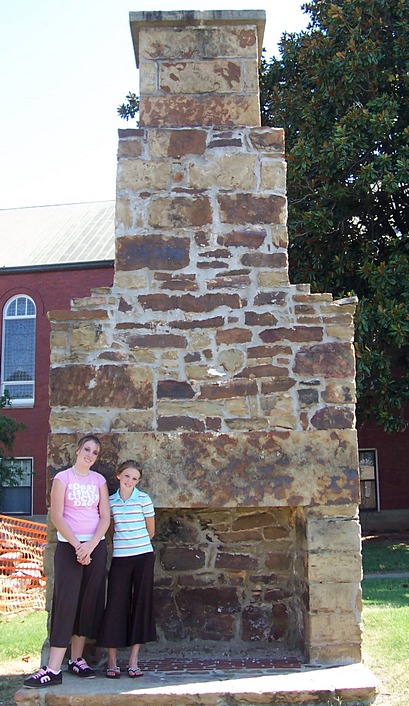
|
| General Zachary Taylor's Mexican American War Home |
| Zachary Taylor's Home in Fort Smith, Arkansas |
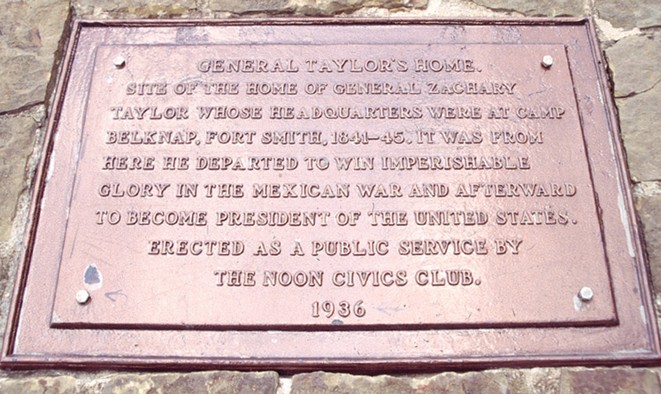
|
| General Zachary Taylor Historical Marker |
(About) During the Mexican-American War, General Zachary Taylor had a home located
forward and nearer to Mexico than his mainstay home back in Louisville, Kentucky. Because of a fire in 1875, all that remains
of Taylor's Fort Smith, Arkansas, home is the chimney. Fort Smith, which is located on the Oklahoma border, was also
home to Hanging Judge Parker. During the Mexican War, present-day Oklahoma (received statehood in 1907) formed much of
Indian Territory and it was considered too far west and barren for the white man to ever desire. At the time, all U.S.
states were east of Arkansas, but with a resounding U.S. victory in 1848, the United States had conquered and now
owned nearly 50% of Mexico, resulting in the creation of California, Nevada, Utah, most of Arizona, about half of New Mexico,
about a quarter of Colorado, and a small section of Wyoming. Texas had been claimed prior to the Mexican Cession, an
agreement signed after the Mexican defeat. Shortly after the creation of the U.S. states carved from Mexico, Indians
would be hard pressed as their reservations came under attack by encroaching whites, and slavery was thrust onto
the political scene with rigor as debates about expansion of the institution into the newly created states became subjects
of immense controversy and discord. Just 13 years after the defeat of Mexico, the United States was thrust into Civil
War, a conflict that pitted Northern states against the newly formed Southern Confederacy. Although civil war had been
stirring for years, it had merely accelerated as a direct result of the US victory over neighboring Mexico.
Sectionalism
Senate Majority Leader Henry Clay took a central role as Congress debated
the statehood question. While his positions had some overlap with Taylor's, the president always maintained his distance from
Clay. Historians disagree on his motivations for doing so. With assistance from Senator Daniel Webster of Massachusetts, Clay
developed his landmark proposal, the Compromise of 1850. The proposal allowed statehood for California, giving it independence
on the slavery question, while the other territories would remain under federal jurisdiction. This would include the disputed
parts of New Mexico, although Texas would be reimbursed for the territory. Slavery would be retained in the District of Columbia,
but the slave trade would be banned. Meanwhile, a strict Fugitive Slave Law would be enacted, bypassing northern legislation
which had restricted Southerners from retrieving runaway slaves. Tensions flared as Congress negotiated and secession talks
grew, culminating with a threat from Taylor to send troops into New Mexico to protect its border from Texas. The omnibus law
was a major step forward but ultimately could not pass, due to extremists on both sides.
No great compromise reached Taylor's desk during his presidency; instead,
his last days were overshadowed by the Galphin affair. Before joining the Taylor cabinet, Secretary of War George W. Crawford
had served as a lawyer. He had been involved in a fifteen-year case, representing the descendants of a colonial trader whose
services to the British crown had not been repaid at the time of the American Revolution. The British debt to George Galphin
was to be assumed by the federal government, but Galphin's heirs only received payment on the debt's principal after years
of litigation, and were unable to win an interest payment from the Polk administration.
Taylor's Treasury Secretary William M. Meredith, with the support of Attorney
General Reverdy Johnson, finally signed off on the payment in April 1850. To the president's embarrassment, this payment included
a legal compensation of nearly $100,000 to Crawford; two cabinet members had effectively offered a tremendous portion of the
public treasury to another. A House investigation cleared Crawford of any legal wrongdoing, but nonetheless expressed disapproval
of his accepting the payment. Taylor, who had already been sketching out a re-organization of his cabinet, now had an unfolding
scandal to complicate the situation.
International Diplomacy
Taylor and his Secretary of State, John M. Clayton, both lacked diplomatic
experience, and came into office at a relatively uneventful time in American–international politics. Their shared nationalism
allowed Taylor to devolve foreign policy matters to Clayton with minimal oversight, although no decisive foreign policy was
established under their administration. As opponents of the autocratic European order, they vocally supported German and Hungarian
liberals in the revolutions of 1848, although they offered little in the way of aid. A perceived insult from the French minister
Guillaume Tell Poussin nearly led to a break in diplomatic relations until Poussin was replaced, and a reparation dispute
with Portugal resulted in harsh words from the Taylor administration. In a more positive effort, the administration arranged
for two ships to assist in the United Kingdom's search for a team of British explorers, led by John Franklin, who had gotten
lost in the Arctic. While previous Whig administrations had emphasized Pacific trade as an economic imperative, the Taylor
administration took no major initiative in the Far East.
Throughout 1849 and 1850, they contended with Narciso López, the Venezuelan
radical who led repeated filibustering expeditions in an attempt to conquer the island of Cuba. While López made generous
offers to American military leaders to support him, Taylor and Clayton saw the enterprise as illegal. They issued a blockade,
and later, authorized a mass arrest of López and his fellows, although the group would eventually be acquitted. They also
confronted Spain, which had arrested several Americans on the charge of piracy, but the Spaniards eventually surrendered them
to maintain good relations with the U.S.
The definitive foreign policy accomplishment of the Taylor administration
was the Clayton–Bulwer Treaty, regarding a proposed inter-oceanic canal through Central America. While the U.S. and
Britain were on friendly terms, and the construction of such a canal was decades away from reality, the mere possibility put
the two nations in an uneasy position. For several years, Britain had been seizing strategic points, particularly the Mosquito
Coast on the eastern coast of present-day Nicaragua. Negotiations were held with Britain that resulted in the landmark Clayton–Bulwer
Treaty. Both nations agreed not to claim control of any canal that might be built in Nicaragua. The treaty promoted development
of an Anglo-American alliance, and its completion was Taylor's last action as president.
| President Zachary Taylor Sculpture |
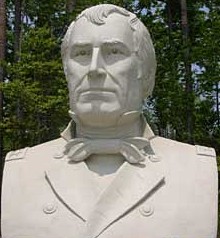
|
| President Zachary Taylor Sculpture |
Death
On July 4, 1850, Taylor reportedly consumed raw fruit, probably cherries,
and iced milk after attending holiday celebrations and a fund-raising event at the Washington Monument, which was then under
construction. Over the course of several days, he became severely ill with an unknown digestive ailment. His doctor "diagnosed
the illness as cholera morbus, a flexible mid–nineteenth-century term for intestinal ailments as diverse as diarrhea
and dysentery but not related to Asiatic cholera," the latter being a widespread epidemic at the time of Taylor's death. The
identity and source of Taylor's illness are the subject of historical speculation, although it is known that several of his
cabinet members had come down with a similar illness. Fever ensued and Taylor's chance of recovery was small. On July 8, Taylor
remarked to a medical attendant:
"I should not be surprised if this were to terminate in my death. I
did not expect to encounter what has beset me since my elevation to the Presidency. God knows I have endeavored to fulfill
what I conceived to be an honest duty. But I have been mistaken. My motives have been misconstrued, and my feelings most grossly
outraged."
Despite treatment, Taylor died at 10:35 p.m. on July 9, 1850. He was 65
years old.
Conspiracy
Immediately after his death, rumors began to circulate that Taylor was poisoned
by pro-slavery Southerners, and similar theories persisted into the twentieth century. In 1978, Hamilton Smith based his assassination
theory on the timing of drugs, the lack of confirmed cholera outbreaks, and other material. In the late 1980s, Clara Rising,
a former professor at University of Florida, persuaded Taylor's closest living relative to agree to an exhumation so that
his remains could be tested. The remains were exhumed and transported to the Office of the Kentucky Chief Medical Examiner
on June 17, 1991. Samples of hair, fingernail, and other tissues were removed, and radiological studies were conducted. The
remains were returned to the cemetery and reinterred, with appropriate honors, in the mausoleum. Neutron activation analysis
conducted at Oak Ridge National Laboratory revealed no evidence of poisoning, as arsenic levels were too low.
The analysis concluded Taylor had contracted "cholera morbus, or acute gastroenteritis",
as Washington had open sewers, and his food or drink may have been contaminated. Any potential for recovery was overwhelmed
by his doctors, who treated him with "ipecac, calomel, opium and quinine (at 40 grains a whack), and bled and blistered him
too." Political scientist Michael Parenti questions the traditional explanation for Taylor's death, and, relying on interviews
and reports by forensic pathologists, argues that the procedure used to test for arsenic poisoning was fundamentally flawed.
A 2010 review concludes: "there is no definitive proof that Taylor was assassinated, nor would it appear that there is definitive
proof that he was not."
Assessment
Taylor was a conscientious military officer, popular with
his subordinates, considerate, and brave, although not one of the truly great commanders. Stocky, sturdy, of medium height,
with furrowed face and graying hair, he habitually wore civilian garb during the Mexican War—preferring a wide-brimmed
straw hat and unmatched trousers and coat. When reviewing his troops on Old Whitey, he liked to sit side-saddle with one leg
casually thrown over the pommel. Afoot he was often taken for a farmer. In Washington,
dressed more formally but with his top hat perched on the back of his head, the President frequently went about unrecognized.
Simplicity, in its best sense, is the word most accurately characterizing Taylor
both before and after he became famous.
Devoted to his invalid wife, his children, and grandchildren, Taylor valued family life and played host to countless relatives. He
became fully reconciled to his son-in-law, Jefferson Davis, who had married Sarah Knox Taylor in 1835 against her father's
wishes only to become a widower three months later. Another Taylor
daughter, Mary Elizabeth ("Betty"), then married to Col. William Bliss, acted as White House hostess during her father's presidency.
A cotton planter, Taylor took an abiding interest not only in land and
crops but particularly in his slaves, who were well treated. Owning 118 slaves when elected president, he acquired 64 more
and a sugar plantation several weeks before he died. Yet he adamantly opposed the extension of slavery. From Taylor's point of view this was not inconsistent. He respected slaveholders' rights in the
15 states where the institution was legal. At the same time, he did not wish to jeopardize the Union
because of the extension issue.
In some Southern eyes, Taylor,
politically, was a doughface in reverse—a Southern man with Northern principles. Fundamentally he was a dedicated Unionist,
a son of the West, a product of the frontier, a patriot who placed the highest value on what he conceived to be national interests
and national welfare.
| Zachary Taylor Home and Historical Marker |
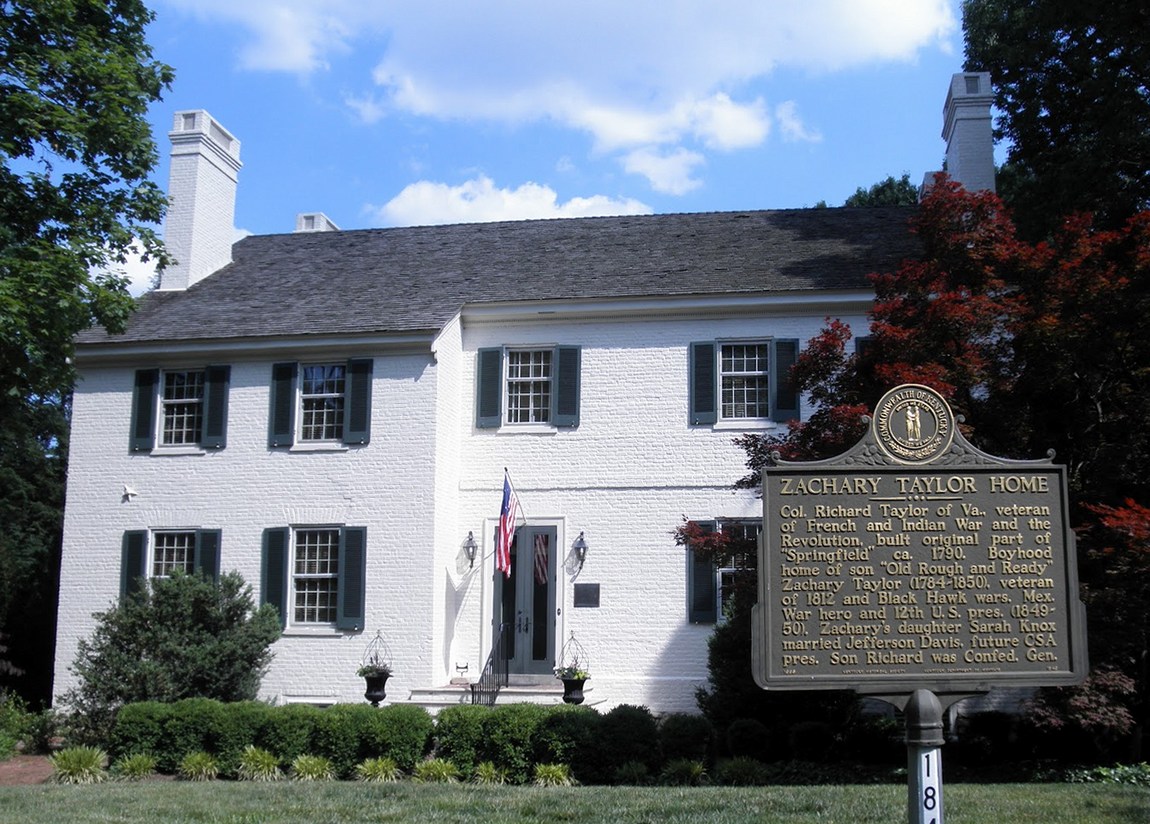
|
| President Zachary Taylor Home in Kentucky |
| President Zachary Taylor Home |
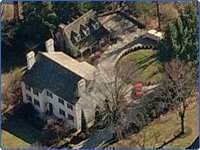
|
| The Zachary Taylor Home. Zillow.com |
(About) The Zachary Taylor House, also known as Springfield, was the boyhood
home of the twelfth President of the United States, Zachary Taylor. Located in Louisville, Kentucky, Taylor lived there from
1790 to 1808, held his marriage there in 1810, and returned there periodically the rest of his life.
Legacy
Because of his short tenure, Taylor is not considered to have strongly influenced
the office of the Presidency or the U.S. Some historians believe that Taylor was too inexperienced with politics, at a time
when officials needed close ties with political operatives. Despite his shortcomings, the Clayton–Bulwer Treaty affecting
relations with Great Britain in Central America is "recognized as an important step in scaling down the nation's commitment
to Manifest Destiny as a policy." While historical rankings of Presidents of the United States have generally placed Taylor
in the bottom quarter of chief executives, most surveys tend to rank him as the most effective of the four Presidents from
the Whig Party.
Taylor was the last President to own slaves while in office. He was the
third of four Whig presidents, the last being Fillmore, his successor. Taylor was also the second president to die in office,
preceded by William Henry Harrison who died while serving as President nine years earlier, as well as the only President elected
from Louisiana.
The US Post Office released the first postage stamp issue honoring Zachary
Taylor on June 21, 1875, 25 years after his death. In 1938, Taylor would appear again on a US Postage stamp, this time on
the 12-cent Presidential Issue of 1938. Taylor's last appearance, 2010, on a US postage stamp occurred in 1986 when he
was honored on the AMERIPEX presidential issue. After Washington, Jefferson, Jackson and Lincoln, Zachary Taylor was the fifth
American president to appear on US postage.
He is the namesake for several names and places throughout the United States,
including:
Camp Taylor in Kentucky and Fort Taylor in Florida.
The SS Zachary
Taylor, a World War II Liberty ship
Zachary Taylor Parkway in Louisiana and in Zachary Taylor Hall at Southeastern Louisiana
University.
Taylor County in Georgia
Taylor County, Iowa
Rough and Ready, California
Zachary Taylor Highway in
Virginia
Contributors
Holman Hamilton, University of Kentucky
Matthew Parker, webmaster
(Sources listed at bottom of page.)
Recommended Reading:
Zachary Taylor: Soldier, Planter, Statesman of the Old Southwest. Description: Zachary Taylor was one of the most unlikely men to ever serve as president of the
United States. Self-educated, an average
and conservative military leader, considered by many to be less than intellectual, but General Zachary Taylor, affectionately
referred to as the soldier’s soldier, was thrust into the limelight because
of his success in the Mexican War. Although a southerner, Taylor opposed the extension of slavery and threatened dire consequences
to secessionists. (Ironically, his son, Richard Taylor, became one of the South’s greatest Civil War generals.) Continued
below...
He died unexpectedly
after serving only sixteen months as president. His death occurred just as he was reorganizing his administration and attempting
a recasting of the Whig Party. Mr. Bauer does a good job of describing the effect that Zachary Taylor had on the nation as
well as that “personal side” of the soldier’s soldier.
Recommended
Reading:
Zachary Taylor: The 12th President, 1849-1850 (The American Presidents) (Hardcover).
Description: The rough-hewn general who rose to the
nation’s highest office, and whose presidency witnessed the first political skirmishes that would lead to the Civil
War. Zachary Taylor was a soldier’s soldier, a man who lived up to his nickname, “Old Rough and Ready.”
Having risen through the ranks of the U.S. Army, he achieved his greatest success in the Mexican War, propelling him to the
nation’s highest office in the election of 1848. He was the first man to have been elected president without having
held a lower political office. John S. D. Eisenhower, the son of another soldier-president, shows how Taylor rose to the presidency, where he confronted the most contentious political issue of
his age: slavery. Continued below...
The political
storm reached a crescendo in 1849, when California, newly populated after the Gold Rush, applied for statehood with an anti-slavery constitution,
an event that upset the delicate balance of slave and free states
and pushed both sides to the brink. As the acrimonious debate intensified, Taylor stood his
ground in favor of California’s admission—despite
being a slaveholder himself—but in July 1850 he unexpectedly took ill, and within a week he was dead. His truncated
presidency had exposed the fateful rift that would soon tear the country apart.
Recommended Reading:
The Presidencies of Zachary Taylor and Millard Fillmore (American Presidency
Series) (Hardcover) (University Press of Kansas). Description: In this book, Elbert B. Smith sharply disagrees with traditional
interpretations of Taylor and Fillmore, the twelfth and thirteenth presidents (from 1848 to 1853). He persuasively argues
that the slaveholding Taylor--and not John C. Calhoun--was the realistic defender of southern slaveholding interests, and
that Taylor
did nothing to impede the Compromise of 1850. While Taylor opposed the combination of the issues into a single compromise
bill that could not be passed without amendments to suit the extremists, he would have approved the different parts of the
Compromise that were ultimately passed as separate measures.
Most historians have written that
Taylor's
death and Fillmore's accession led to an abrupt change in presidential policy, but Smith believes that continuity predominated.
Taylor wanted the controversies debated and acted upon as
separate bills; Fillmore helped to accomplish it. Taylor had desired statehood for California and New Mexico with self-determination,
or popular sovereignty, on slavery. As separate measures, the Congress admitted California
and preserved a viable New Mexico as a “territory
authorized to make its own decision on slavery.” With secessionists pitted against moderates in the southern elections
of 1851, Fillmore had to choose between his constitutional oath and his personal antipathy to the new fugitive slave law.
He supported the law and thereby helped keep southern moderates in power for a few more years. In fact, however, his efforts
did not recapture a single slave. In Smith's view, Fillmore's most serious mistake was refusing a second term. Smith argues
that Taylor and Fillmore have been seriously misrepresented and underrated. They faced a terrible national crisis and accepted
every responsibility without flinching or directing blame toward anyone else.
Recommended
Reading: President Zachary Taylor: The Hero President (First Men, America's Presidents) (Hardcover).
Description: Zachary Taylor (November 24, 1784 - July 9, 1850) was an American military leader and the twelfth President of
the United States.
Taylor had a 40-year military career in the U.S. Army, serving
in the War of 1812, Black Hawk War, and Second Seminole War before achieving fame while leading U.S.
troops to victory at several critical battles of the Mexican-American War. Continued below…
Taylor's short Presidency was shadowed by the issue then dominating all
aspects of American national affairs - that of slavery. However, the immediate issue was the admission of New Mexico and California as states. Taylor confounded his Southern
supporters, who had assumed that since the President owned slaves, he would support the pro-slavery position and refuse entry
into the union to two states settled by Northerners and likely to be anti-slavery. Taylor recommended that the two territories develop
their own constitutions and then request admission based on those constitutions. When Southern states threatened secession
he warned them that he would use all his resources as commander-in- chief to preserve the union. He stated that if they seceded
he would track them down like he had the Mexicans, and handle them in the same manner that he had deserters. Taylor's brief term in the
White House also featured the still on-going question of balancing power between the Congress and the presidency.
Recommended Reading: Letters Of Zachary Taylor
From The Battlefields Of The Mexican War (1908). Review: If you are interested in this influential episode of US history, this book conveys
it straight from the proverbial horse’s mouth. In contrast with often one-sided accounts like President Polk's and others’
memoirs, this book displays the human side of the invasion of Mexico. General Taylor reveals
that he was conflicted in many standpoints ranging from ethical to military and political. Although he understood that it
was his duty to serve his country and fight in a war against the weaker neighbor, Mexico, he shows us an emotional and personal side rarely seen in America’s
top brass.
Recommended
Reading: The Radicalism of the American Revolution. From Library Journal: Historians have
always had problems explaining the revolutionary character of the American Revolution: its lack of class conflict, a reign
of terror, and indiscriminate violence make it seem positively sedate. In this beautifully written and persuasively argued
book, one of the most noted of U.S. historians
restores the radicalism to what he terms "one of the greatest revolutions the world has ever known." It was the American Revolution,
Wood argues, that unleashed the social forces that transformed American society in the years between 1760 and 1820. Continued
below...
The change
from a deferential, monarchical, ordered, and static society to a liberal, democratic, and commercial one was astonishing,
all the more so because it took place without industrialization, urbanization, or the revolution in transportation. It was a revolution of the mind, in which the concept of equality,
democracy, and private interest grasped by hundreds of thousands of Americans transformed a country nearly overnight. Exciting,
compelling, and sure to provoke controversy, the book will be discussed for years to come.
Sources: Library of Congress; National Archives; National Park Service; Veterans Affairs; Bauer,
K. Jack, Zachary Taylor: Soldier, Planter, Statesman of the Old Southwest, ed. by William J. Cooper, Jr. (La. State Univ.
Press 1985); Farrell, J. J., Zachary Taylor, 1784–1850 and Millard Fillmore, 1800–1874 (Oceana
Pubns. 1971); Smith, Elbert B., The Presidencies of Zachary Taylor and Millard Fillmore (Univ. Press of
Kans. 1988); Content provided by Encyclopedia Americana; Bauer, K. Jack (1985). Zachary Taylor: Soldier,
Planter, Statesman of the Old Southwest. Louisiana State University Press. ISBN 0-8071-1237-2; Dyer, Brainerd (1946). Zachary
Taylor. Southern Biography series. Louisiana State University Press; Eisenhower, John S.D. (2008). Zachary Taylor. The American
Presidents series. Times Books (Macmillan). ISBN 978-0-8050-8237-1; Hamilton, Holman (1941). Zachary Taylor: Soldier of the
Republic. [vol. 1]. Indianapolis, Ind.: Bobbs-Merrill Company; Hamilton, Holman (1951). Zachary Taylor: Soldier in the White
House. [vol. 2]. Indianapolis, Ind.: Bobbs-Merrill Company; McKinley, Silas B.; Bent, Silas (1946). Old Rough and Ready: The
Life and Times of Zachary Taylor. New York: Vanguard Press; Holt, Michael F (1999). The Rise and Fall of the American Whig
Party: Jacksonian Politics and the Onset of the Civil War. Oxford University Press. ISBN 978-0-19-505544-3; Silbey, Joel H.
(2009). Party Over Section: The Rough and Ready Presidential Election of 1848. University Press of Kansas. ISBN 978-0-7006-1640-4;
Smith, Elbert B. (1988). The Presidencies of Zachary Taylor and Millard Fillmore. University Press of Kansas. ISBN 0-7006-0362-X;
Lossing, Benson J (1888). The American nation: its executive, legislative, political, financial, judicial and industrial history:
embracing sketches of the lives of its chief magistrates, its eminent statesmen, financiers, soldiers and jurists, with monographs
on subjects of peculiar historical interest, Volume 2. Williams Publishing Co.; Jones, Emma C. Brewster (1908). The Brewster
Genealogy, 1566–1907: a Record of the Descendants of William Brewster of the "Mayflower," ruling elder of the Pilgrim
church which founded Plymouth Colony in 1620. New York: Grafton Press; Otto, Julie Helen; Roberts, Gary Boyd (1995). Ancestors
of American Presidents. Santa Clarita, Calif.: New England Historic Genealogical Society. ISBN 0-936124-19-9.
|

